Experimental field test of six exotic tree species
2011 - 2023
Cooperation Financing
«Experimental field test of six exotic tree species» is an international cooperative project of research institutions and universities (lead: LWF Bayern). The project aims at testing the suitability of six little-known exotic tree species for use in a future warmer and drier climate. An additional objective is to check whether the roots of the selected tree species will be sufficiently colonized with mycorrhizal fungi at the target sites.
Contents
Methods
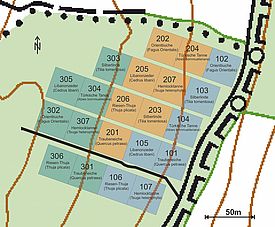
The seed originates from Bulgaria, Turkey and the USA. The tree species have been selected with a sophisticated test procedure based on ecological and economic criteria to ensure, e.g., that a species is not invasive and not vulnerable to pests and diseases, and that the wood can be utilized (Schmiedinger et al. 2009). When selecting the species, a warming by 2 °C was assumed. The 6 exotic tree species are compared with one native species at each site, in Mutrux with sessile oak (Quercus petraea). The seedlings were produced in nurseries starting in autumn 2009, and planted to the field sites in autumn 2012.
The trial was established as experimental block design with 7 treatments (=tree species) und 3 replicates. The trial near Mutrux covers an area of 3 ha, and each of the 21 experimental units is 0.12 ha in size. The spacing is 2 m x 2 m. This design enables the observation of a sufficient number of trees of each species till the small timber stage is reached.
The methods for assessing vegetation and soil parameters and the performance of the planted trees are agreed upon with the project partners (parameters, measurement method, time, sample) to ensure a homogenized data base. The focus is on tree growth, mortality and phenology, as well as pests and diseases. A separate study is conducted to assess the mycorrhization of the seedlings when they are taken from the nursery, and one year later at the experimental site.
What are exotic tree species?
Exotic tree species are species introduced to an area where they do not occur naturally. Such species must initially be planted, but may be able to regenerate naturally later.
The seven tree species
Turkey fir
Abies bornmuelleriana
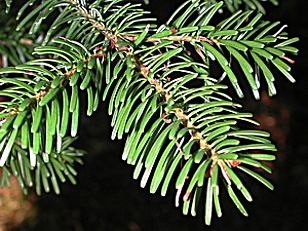
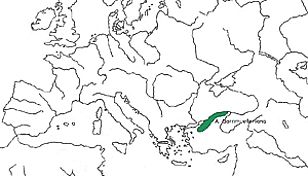
Oriental beech
Fagus orientalis
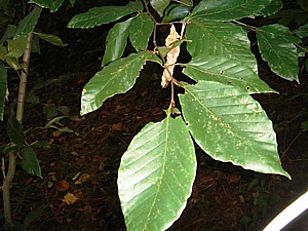
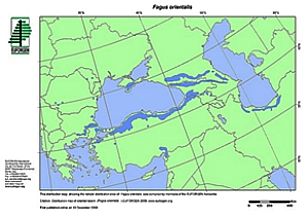
Silver lime
Tilia tomentosa
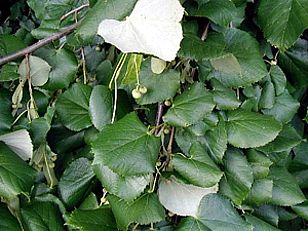
Lebanon cedar
Cedrus libani
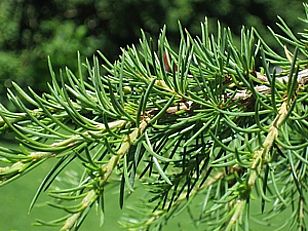
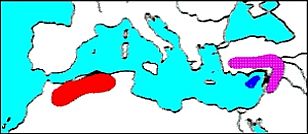
Pacific redcedar
Thuja plicata
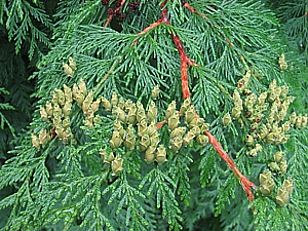
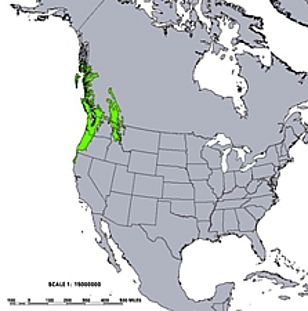
Tsuga de Californie
Tsuga heterophylla
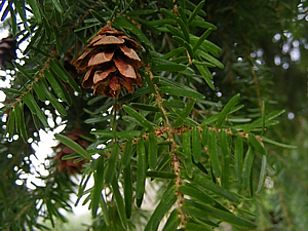
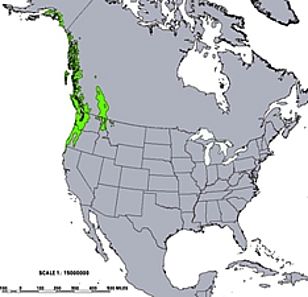
Sessile oak
Quercus petraea
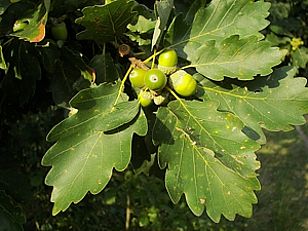
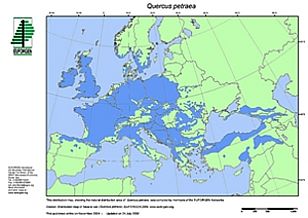
Why planting exotic tree species?
For centuries, plant lovers, gardeners and foresters have been experimenting with exotic tree species in parks, gardens and forests. Their motivation is the fascination for the alien, the admiration for giant trees and an economic interest in fast growing timber trees. Most exotic tree species proved to be a failure. Few of them continue to be used, e.g., the Monterey pine (Pinus radiata), a species used worldwide in commercial plantations, and in Switzerland Douglas fir (Pseudotsuga menziesii) and red oak (Quercusrubra). Moreover, few experimental plantations with Atlas cedar (Cedrus atlantica) exist in Switzerland. Today there is a revived interest in exotic tree species since it is feared that climate change could cause failure of tree species with economic importance such as Norway spruce (Picea abies). Therefore, as a replacement, species are sought with similar wood properties but which sustain a warmer and drier climate.
Expected results and relevance for practical application
The field trial enables us to judge how well the species survive, grow and stay free of pests and diseases, as well as to what degree their roots are mycorrhized.
After a few years, the project will result in tentative recommendations for further use of the tested tree species. With increasing duration of the trial, the recommendations will become more robust. The goal is not to replace the tree species currently present in Switzerland, but to mix suitable exotic species, in small proportions, with well-proven species.
Publications
Links
Internal publications
Nikolova P, Bürgi A, Egli S, Brang P. 2016. Schlussbericht des Projektes Gastbaumarten im Forschungsprogramm Wald und Klimawandel. Birmensdorf, Eidg. Forschungsanstalt für Wald, Schnee und Landschaft WSL. 52 S.
Schmiedinger A, Bachmann M, Kölling C, Schirmer R. 2009. Verfahren zur Auswahl von Baumarten für Anbauversuche vor dem Hintergrund des Klimawandels. Forstarchiv 80: 15-22.
Spellmann H, Brang P, Hein S, Geb M. 2015. Grosse Küstentanne (Abies grandis Dougl. ex D. Don Lindl.). [Kapitel 4.1] In: Vor T, Spellmann H, Bolte A, Ammer C (eds) Potenziale und Risiken eingeführter Baumarten. Baumartenportraits mit naturschutzfachlicher Bewertung. Göttinger Forstwissenschaften. Band 7. Göttingen, Universitätsverlag. 29-46.
Spellmann H, Weller A, Brang P, Michiels H-G, Bolte A. 2015. Douglasie (Pseudotsuga menziesii (Mirb.) Franco). [Kapitel 4.12] In: Vor, T.; Spellmann, H.; Bolte, A.; Ammer, C. (eds) Potenziale und Risiken eingeführter Baumarten. Baumartenportraits mit naturschutzfachlicher Bewertung. Göttinger Forstwissenschaften. Band 7. Göttingen, Universitätsverlag. 187-217.
Als Vorbereitung auf die Versuchspflanzung wurde nach den wenigen bestehenden Anbauten der in Mutrux angepflanzten Baumarten gesucht. Das Resultat ist in 2 Berichten dokumentiert: